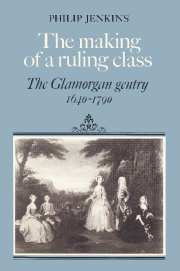Book contents
- Front matter
- Contents
- List of maps and tables
- Acknowledgments
- Abbreviations
- General introduction
- PART I SOCIAL AND ECONOMIC STRUCTURE
- PART II LOCAL AND NATIONAL POLITICS
- PART III SOCIETY AND CULTURE
- Conclusion to Part III: ‘conspicuous antiquity’
- Aftermath: towards the Victorian world
- Conclusion: from Civil War to Industrial Revolution
- Appendix 1 Parliamentary service by Glamorgan landowners 1640 – 1800
- Appendix 2 The ‘secondary’ gentry families
- Appendix 3 The ‘tertiary’ families
- Appendix 4 The Mansell family and their connections with the greater gentry
- Appendix 5 The roundhead and puritan family links of the Thomases of Wenvoe
- Notes
- Index
Conclusion to Part III: ‘conspicuous antiquity’
Published online by Cambridge University Press: 22 September 2009
- Front matter
- Contents
- List of maps and tables
- Acknowledgments
- Abbreviations
- General introduction
- PART I SOCIAL AND ECONOMIC STRUCTURE
- PART II LOCAL AND NATIONAL POLITICS
- PART III SOCIETY AND CULTURE
- Conclusion to Part III: ‘conspicuous antiquity’
- Aftermath: towards the Victorian world
- Conclusion: from Civil War to Industrial Revolution
- Appendix 1 Parliamentary service by Glamorgan landowners 1640 – 1800
- Appendix 2 The ‘secondary’ gentry families
- Appendix 3 The ‘tertiary’ families
- Appendix 4 The Mansell family and their connections with the greater gentry
- Appendix 5 The roundhead and puritan family links of the Thomases of Wenvoe
- Notes
- Index
Summary
The history of the Glamorgan gentry in the eighteenth century is overwhelmingly a story of detachment from local culture and loyalties, and the adoption of metropolitan ways: only by pursuing racing and hunting could they emphasise that they had not entirely lost their ‘country’ identity. But at the end of our period, we can observe a curious irony. From about 1760, fashionable society discovered a new subject for literature, and a model for artistic styles, in Celtic and medieval antiquities. When the real political threat from the old Celtic areas had subsided after 1745, it became possible for the rich of south-east England to turn their sympathies and studies to the forgotten corners of the island – Scotland chiefly, but also Wales. Iolo's druids of the 1790s provided ample material for this protoromanticism, and the remote valleys of Glamorgan became an appropriate setting for novels – books like The Fair Cambrians of 1790.
So just as the Glamorgan gentry were rejecting the historical and architectural heritage of their county, so others were discovering it. In the 1780s, Lord Torrington remarked disparagingly on the Glamorgan squire who built classical houses overrun with ‘fashionable’ Italian paintings, while letting their own family homes decay. He was particularly thinking of Thomas Mansell-Talbot, who at this time was demolishing the Mansell house at Margam and creating a complete ‘picturesque’ environment for his new home at Penrice in Gower.
Information
- Type
- Chapter
- Information
- The Making of a Ruling ClassThe Glamorgan Gentry 1640–1790, pp. 272 - 273Publisher: Cambridge University PressPrint publication year: 1983
